A recently shared image on social media has highlighted China‘s naval aspirations, featuring the fourth Type 075 amphibious assault ship, provisionally named Hubei, as it navigates open waters during what seems to be sea trials.
This event, noted in early May 2025, indicates that the vessel is approaching operational readiness with the People’s Liberation Army Navy, thereby enhancing China’s capacity to project power throughout the Indo-Pacific. Built at the Hudong-Zhonghua Shipyard in Shanghai, this ship exemplifies Beijing’s swift naval expansion, raising concerns about its strategic objectives and the implications for the United States and its allies.
This achievement, while cloaked in China’s typical secrecy, emphasizes an increasing ability to perform intricate amphibious operations, which could alter regional security dynamics. The Type 075, frequently likened to the U.S. Navy’s Wasp-class amphibious assault ships, is a powerful platform intended to facilitate various military operations, ranging from troop landings to humanitarian efforts.
With a full load displacement estimated between 35,000 and 40,000 tons, it ranks among the largest of its type worldwide. Its spacious flight deck can support up to 30 helicopters, including the Z-20 naval variant and the Z-8 transport helicopter, allowing for swift air asset deployment. The ship’s well deck accommodates air-cushioned landing craft and amphibious vehicles, capable of ferrying around 900 marines and their gear to shore. This capability enables the Type 075 to carry out extensive amphibious assaults, a vital aspect of China’s military strategy in contested areas such as the South China Sea and the Taiwan Strait.
The vessel’s sensor systems and armament significantly improve its operational flexibility. Featuring the Type 346A radar, a dual-band system akin to those utilized on China’s Type 052D destroyers, the Type 075 offers sophisticated air and surface monitoring capabilities. For its defense, it is equipped with two HQ-10 short-range surface-to-air missile systems and two H/PJ-11 close-in weapon systems, each comprising a 30mm Gatling-style gun designed to intercept missiles and small boats.
Although there are unverified reports about the possible integration of anti-ship missiles like the YJ-83, there is no public evidence confirming this capability. The ship’s electronic warfare systems, while not fully detailed, are thought to incorporate jamming and decoy technologies to safeguard against missile threats.
Collectively, these features render the Type 075 a formidable platform, capable of operating in high-threat scenarios alongside China’s expanding fleet of destroyers and aircraft carriers.
China’s naval modernization efforts have been unyielding, with the Type 075 program showcasing its shipbuilding capabilities. The first ship of this class, Hainan, was commissioned in April 2021, followed by Guangxi and Anhui in 2022 and 2023, respectively. The fourth vessel, which has been observed in trials, is anticipated to join the fleet by late 2025, barring any significant delays.
Posts on X, including one from user @gaofrank75 on May 10, 2025, assert that the Hubei has already been commissioned, although there is no official confirmation from Beijing to validate this claim.
The fourth 075 – type amphibious assault ship, rumored to be named “Hubei” ship, has entered service. It’s a symbol of China’s growing naval strength, enhancing maritime defense capabilities. 🚢💪 #HubeiShip #NavalPower pic.twitter.com/K3nGPQPSe4
— GaoFrank🇨🇳🇺🇸🇩🇪🇨🇦 (@gaofrank75) May 10, 2025
The swift construction timeline—less than a year from launch to trials for the fourth ship—reflects China’s wartime-like shipbuilding efficiency, as noted by analysts who compare it to U.S. production during World War II. This rapid pace not only highlights industrial capability but also indicates strategic urgency, as China aims to establish dominance in its adjacent seas and beyond.
Amphibious assault ships have historically been crucial in military operations, from the D-Day landings in Normandy to the Falklands War, where their capacity to launch land forces from the sea was vital. The Type 075 continues this tradition, evolving to meet the requirements of contemporary warfare. Equipped with helicopters and landing craft, it allows for swift troop deployment, while its command-and-control systems enhance coordination with other naval forces, including the Type 055 destroyer and the Fujian aircraft carrier.
In a potential conflict over Taiwan, the Type 075 could transport marines to beaches or captured ports, with air support from carrier-based J-15 fighters. Likewise, in the South China Sea, it could assist in operations to reinforce or capture contested islands, such as those in the Spratly chain, where China has established militarized outposts.
The design of the ship is influenced by Western models but features unique Chinese innovations. In contrast to the U.S. Wasp-class, which displaces approximately 40,500 tons and accommodates a combination of helicopters and F-35B jets, the Type 075 does not include fixed-wing aircraft but offers advantages in cost and production speed. While the Wasp-class provides greater versatility in air operations due to its capability to deploy short-takeoff vertical-landing aircraft, the Type 075’s emphasis on helicopter-based assaults is more aligned with China’s regional strategic objectives.
In contrast, the Russian Kuznetsov-class is a hybrid carrier with limited amphibious capabilities, making it a less relevant comparison. The closest competitor to the Type 075 may be Japan’s Izumo-class, which, although smaller at 27,000 tons, is being upgraded to accommodate F-35Bs, reflecting a regional shift towards adaptable naval platforms. China’s naval strategy, often characterized as an ‘anti-access/area denial’ (A2/AD) approach, utilizes vessels like the Type 075 to deter or delay U.S. and allied involvement in regional conflicts.
By deploying several Type 075s alongside Type 055 destroyers and Type 054A frigates, China can establish layered defenses that complicate access to contested waters. The ships’ capability to function within distributed task forces, supported by satellite and drone reconnaissance, enhances their survivability and operational effectiveness. During exercises in the South China Sea in 2023, the Hainan showcased its ability to coordinate helicopter landings and small-boat operations, simulating potential real-world scenarios.
These drills highlight China’s aim to integrate its amphibious fleet into a comprehensive networked warfare framework, where data links and real-time intelligence are crucial for operational success. The introduction of the fourth Type 075 aligns with China’s broader naval expansion, which includes the Type 076, a larger amphibious assault ship launched in December 2024. Named Sichuan, the Type 076 features an electromagnetic catapult system, potentially enabling it to operate fixed-wing drones or light aircraft, marking a significant advancement over the capabilities of the Type 075.
A Bloomberg report indicates that Sichuan’s 40,000-ton displacement and sophisticated features enable it to serve as a hybrid between an amphibious vessel and a light aircraft carrier, showcasing China’s intent to redefine conventional naval roles. The ongoing development of the Type 076 at the same Shanghai shipyard implies that China aims not merely to imitate Western designs but to achieve technological dominance in naval warfare.
The strategic ramifications of China’s expanding amphibious fleet are significant, particularly for the United States and its allies in the Indo-Pacific region. Countries like Japan, Australia, and the Philippines, which have territorial or maritime disputes with China, are under heightened pressure as Beijing’s naval capabilities grow. The Type 075’s capacity to project power onto land poses a threat to smaller island nations and U.S. forward bases, including those in Okinawa and Guam.
In response, the U.S. Navy has made it a priority to counter amphibious threats through strategies such as the Marine Corps’ Expeditionary Advanced Base Operations concept, which envisions agile, mobile units capable of disrupting enemy landings. Furthermore, initiatives like the AUKUS partnership, which includes the provision of nuclear-powered submarines to Australia, are designed to counterbalance China’s numerical superiority in surface vessels. However, challenges persist for China’s amphibious aspirations, as operating four Type 075s necessitates substantial logistical support, including trained personnel, maintenance facilities, and supply chains capable of sustaining extended deployments.
Analysts are raising concerns about whether China’s naval infrastructure can match its shipbuilding capacity, especially in high-intensity conflicts where attrition rates may be significant.
The Falklands War serves as a warning, illustrating the logistical challenges faced by Britain’s task force despite the smaller scale of the conflict.
Additionally, the Type 075’s dependence on helicopters renders it susceptible to advanced air defenses, such as those utilized by Taiwan or U.S. forces, which could incapacitate its landing operations before troops can disembark.
Meanwhile, the U.S. Navy is actively advancing its capabilities; the USS Preble, a destroyer outfitted with the HELIOS laser weapon, conducted tests in 2024 aimed at countering unmanned aerial vehicles, a potential risk to amphibious vessels like the Type 075.
A report in February 2025 noted that the 60-kilowatt laser can blind drone sensors, providing a cost-effective defense against swarms targeting significant naval assets. These developments underscore the ongoing technological arms race in the Pacific, where both sides are striving to exploit each other’s weaknesses.
The U.S. also holds a numerical advantage in aircraft carriers, operating 11 compared to China’s three, although China’s carrier program, including the nuclear-powered Type 004, is advancing swiftly. The evolution of the Type 075 signifies a broader shift in naval warfare, emphasizing the importance of versatility and integration.
Unlike the specialized carriers of the Cold War, contemporary ships are required to fulfill multiple functions, ranging from power projection to disaster response. China’s focus on enhancing its amphibious capabilities reflects its strategic transition from a continental to a maritime power, a shift that commenced with the acquisition of the Liaoning carrier in 1998.
The vessel, initially a Soviet structure acquired from Ukraine, signified the inception of China’s aircraft carrier initiative, which now encompasses the conventionally powered Shandong and Fujian. Although the Type 075 may not be as prestigious as a carrier, it plays a vital role in China’s ambition to assert control over its maritime boundaries and counter U.S. supremacy in the Pacific.
The impending completion of the fourth Type 075 raises important questions regarding China’s industrial capabilities and their ramifications for global security. The Hudong-Zhonghua Shipyard, a division of the China State Shipbuilding Corporation, has proven its capacity to manufacture sophisticated warships at a speed that outpaces its Western rivals. A 2023 update on X highlighted that the fourth Type 075 was launched in less than a year, a success attributed to China’s centralized planning and extensive industrial resources. This level of efficiency stands in stark contrast to U.S. shipbuilding, which often encounters delays and budget overruns, as evidenced by the Littoral Combat Ship program.
While the U.S. retains technological superiority in areas such as stealth and cyber warfare, China’s production capabilities pose a significant challenge to the Pentagon’s ability to sustain a forward presence in Asia. As the Hubei prepares to join its sister vessels, its significance in China’s naval strategy will be increasingly examined. The ship’s trials, conducted in the waters near Shanghai, serve as a public affirmation of China’s determination to dominate its adjacent seas and extend its influence well beyond.
For the United States, the challenge lies not only in matching China’s fleet size but also in formulating strategies that capitalize on the Type 075’s weaknesses, whether through advanced weaponry, cyber tactics, or unconventional approaches. The Indo-Pacific remains a battleground of fierce rivalry, and the introduction of another Type 075 amplifies the stakes.
Ultimately, the fourth Type 075 signifies more than just a vessel; it reflects China’s aspiration to establish itself as a formidable maritime power. Its capacity to transport troops, helicopters, and landing craft to far-off locations provides Beijing with strategic options that were unavailable a decade ago, ranging from the occupation of contested islands to dissuading U.S. involvement in a Taiwan crisis.
However, the ship’s real influence will hinge on China’s capability to incorporate it into a unified naval force, a challenge that demands more than just advanced materials and technology. For U.S. decision-makers, the critical issue is whether existing defense strategies—focused on aircraft carriers and advanced fighter jets—can evolve to address a scenario where amphibious operations could determine the results of future conflicts.
As China’s naval capabilities expand, will the U.S. and its allies muster the determination to respond to this emerging challenge, or will they find themselves unprepared in an increasingly dynamic strategic environment?
Discover more from Defence Talks | Defense News Hub, Military Updates, Security Insights
Subscribe to get the latest posts sent to your email.





